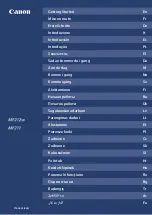
4
.1
<Network setup>
4
Network setup
This chapter gives you step-by-step instructions for setting up your
machine for network connections.
This chapter includes:
•
Introduction
•
Supported operating systems
•
Configuring TCP/IP
•
Configuring EtherTalk
•
Setting Ethernet speed
•
Restoring the network configuration
•
Printing a network configuration page
Introduction
Once you have connected your machine to a network with an RJ-45
Ethernet cable, you can share the machine with other network users.
You need to set up the network protocols on the machine to use it as your
network printer. Protocols can be set up by the following two methods:
Via network administration programs
You can configure your machine’s print server settings and manage the
machine via the following programs that came with your machine:
•
Web Image Monitor Type 104
: A web server embedded to your
network print server, which allows you to:
- Configure the network parameters necessary for the machine to
connect to various network environments.
- Customize e-mail settings and set up
Address Book
for scanning
to email.
- Customize server settings and set up
Address Book
for scanning
to an FTP or SMB servers.
- Customize printer, copy, and fax settings.
•
SetIP
: A utility program allowing you to select a network interface and
manually configure the addresses for use with the TCP/IP protocol.
For further details, refer to the user’s guide on the
Printer, Scanner
Drivers and Utilities Type 104 CD
that came with your machine.
Via the control panel
You can set up the following basic network parameters through the
machine’s control panel:
• Configure TCP/IP
• Configure EtherTalk
Supported operating systems
The following table shows the network environments supported by the
machine:
• TCP/IP: Transmission Control Protocol/Internet Protocol
• DHCP: Dynamic Host Configuration Protocol
• BOOTP: Bootstrap Protocol
Configuring TCP/IP
Your machine can be set up with a variety of TCP/IP network information,
such as an IP address, a subnet mask, a gateway, and DNS addresses.
There are several ways in which your machine can be assigned a TCP/
IP address, depending on your network.
• Static addressing: A TCP/IP address is assigned manually by the
system administrator.
• Dynamic addressing via BOOTP/DHCP (default): A TCP/IP address is
assigned automatically by the server.
Note
Before configuring TCP/IP, you need to set the network protocol
to TCP/IP.
Item
Requirements
Network interface
• 10/100 Base-TX
Network operating
system
• Windows 98/Me/NT 4.0/2000/XP/2003
• Macintosh OS 10.3 ~ 10.4
Network protocols
• TCP/IP on Windows
• EtherTalk
Dynamic addressing
server
• DHCP, BOOTP
Summary of Contents for Laser MFP
Page 92: ......
Page 93: ...Software section ...
Page 129: ......
Page 130: ...Laser MFP User s Guide G960 8650 ...
Page 149: ...G960 8651 ...
Page 150: ......
Page 159: ...G960 8651 ...
















































